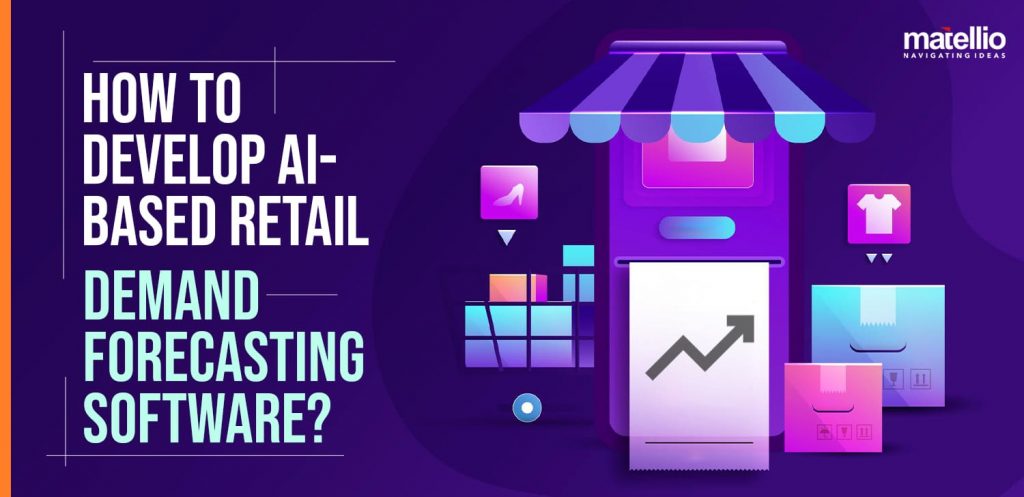
Most successful businesses are built on accurate forecasts. Forecasts help you see the future more clearly, and you may make an effective plan with this clarity. In the retail sector, precise estimates can assist you in making decisions about how much inventory to carry, how many customer service representatives to have on call, and how to prevent encountering a liquidity problem if you notice future rises in material costs.
Every retailer’s business model focuses on demand forecasting, and for a legitimate reason: the demand forecast is crucial to sales, revenue, and the customer shopping experience, and it influences the whole supply chain.
One of the critical components of managing a successful retail business is demand forecasting. Demand forecasting allows a retailer to correctly determine and prepare for evolving market conditions and customer needs. Demand forecasting is one such essential element. Additionally, forecasting makes predictions about future performances using statistics from historical data.
That’s where AI-based demand forecasting software comes to play!
But what exactly is demand forecasting software, and why must retail businesses use it? Let’s find out!
In today’s blog, we’ll discuss all you need to know about demand forecasting software. We’ll also explore key benefits, features, and how to develop AI-based demand forecasting software for your retail business. So, let’s get started!
What is Demand Forecasting Software?
It is one of the distinctive retail IT solutions that lessens product waste while addressing inventory difficulties. It also expedites analyzing unstructured data, accelerates forecasting, avoids stock-out situations, and accelerates data processing.
The market for demand planning solutions worldwide, which had a value of USD 3.6 billion in 2021, is anticipated to increase at a CAGR of 10.3% from 2022 to 2030.
For forecasting, this implies that massive amounts of data are automatically analyzed by AI techniques to find patterns and relationships that would be too laborious or time-consuming for people to identify. Algorithms can analyze all the data, not just a portion of it, at the level as they are automated. By tackling data that receives little to no human attention, they can unlock tremendous business value.
Moving ahead, let’s discuss,
How Does AI-Based Demand Forecasting Software Work?
Demand forecasting software makes use of cutting-edge technologies like AI and machine learning to make forecasts about demand trends in the future that are more accurate. Unlike the slow, time-consuming, and inaccurate traditional techniques of demand forecasting, such as spreadsheets and manual analytics.
The retail demand forecasting software initially analyzes the demand patterns of the company before making predictions about future goals using its self-learning capabilities. Users and the business both profit from the forecast that software produces. AI development services enable the developing or upgrading of demand forecasting software to next-generation software, that is customized to industry requirements.
Why Is Demand Forecasting Software Important for Retail Businesses in 2023?
By assessing and anticipating demand, demand planning & forecasting software enables retail firms to make wise operational decisions. Retail businesses must allocate their resources as effectively as possible because today’s companies rely on easy logistics and a global consumer base.
Artificial intelligence is not just constrained to predicting sales and demand. It has made it simpler to predict future trends, customer behavior, marketing initiatives, brand development, financing decisions, and resource utilization, among other things. The potential of demand forecasting software powered by AI depends on how effectively retail business owners leverage it.
If you’re still not impressed, consider these reasons and advantages of retail demand forecasting software for retail businesses:
Ensures Optimal Accuracy
Accuracy is one of the most important aspects of forecasting in the retail demand planning process. Businesses must employ forecasting methods that have been proven and are guaranteed to be accurate.
Demand forecasting automates the processes involved in inventory management. The headache of handling inventories is taken away from the retailers. The inventories were organized according to user preferences, requirements, and profit potential. It is one of the main aims behind using AI in demand forecasting software.
Ensure Fast Decision Making
Demand forecasting software improves analytical speed and accuracy, which in turn facilitates quicker decision-making and shortens the turnaround time for the entire supply chain. Improved decision-making and operations speed up profit margins.
Helps to Reduce Latent Inventory
Ordering a tonne of raw materials is a frequent practice when working with an overseas supplier, as it saves time. On the other hand, while you wait for orders to come, you’re wasting money and space by holding useless raw materials. You can manage inventories and get the necessary paperwork from suppliers through retail demand forecasting software.
Enhances Profitability
Retail businesses can increase profitability by using smart AI solutions to forecast demand. By identifying the optimal period for product sales, the tailored AI-based demand planning and forecasting software to automate demand forecasting and lower operating expenses. Eventually, the businesses will be able to guarantee improved and efficient business operations. Additionally, it helps companies save money that would otherwise be spent on compensating for losses and acquiring personnel.
Boosts Customer Experience
The nature of the product and the timing of delivery have a significant impact on customer satisfaction.
A retail business can predict product demand through demand planning and forecasting software, allowing the most effective fulfillment of consumer orders. You may create lasting, meaningful relationships with your customers with this technique.
Also Read: How Machine Learning Helps in Demand Forecasting in Retail?
Top Features of Demand Planning and Forecasting Software!
Following are some features you can add to your custom demand forecasting software development!
Real-Time Analysis
You can get real-time visibility into your demand planning process with the help of this functionality. Analyze the process’ current state, identify the accountable party, and have complete knowledge of the company’s actuals and projected units.
Dashboard
You may drill down into specifics and evaluate demand fluctuations, KPIs by goods, customers, geographies, and any other business aspects using the dashboard functionality.
Manage Product Portfolio
With the help of this feature, you can analyze the implications of new product introductions on the entire company while planning for product life cycles with real-time portfolio data. Utilize curve-fit and commoditization modeling to fine-tune new items and promotions, and include promotion planning right into your plans. You may effectively collaborate with sales and marketing initiatives thanks to this functionality.
Social Media Analytics
Retail companies may successfully present their product to their target audience using this demand planning and forecasting software feature. The useful information on the preferences of the customers aids businesses in providing total contentment and enhancing their brand equity.
Adjust Price
Demand forecasting for retail can provide valuable data for pricing strategy in a price-sensitive industry like retail. Before choosing the optimal product price, businesses can compare the effectiveness of several pricing models with AI-based demand forecasting software. Retailers’ prices may vary depending on the season, competing products, and consumer demand.
Integration
Demand planning frequently requires integrating real sales and output data from a CRM or other ERP system. Many demand plans start with the integration of precise sales data, including units and pricing that have been segmented by a number of characteristics. Your custom retail demand forecasting software offers direct integration connections with various systems with the aid of this functionality, allowing you to monitor both past sales and future demand projections through a single interface.
Econometric Forecasting
You can utilize the econometric forecasting feature to build a relationship between the variables that affect supply and demand, including the timing of day and seasonality.
How to Develop AI-Based Retail Demand Forecasting Software?
Here, we’ll take you step-by-step through each part of the demand forecasting software development life cycle process, which includes a number of stages, including:
Start with Brainstorming
If you are unsure of the scope or complexity of your project at this point, brainstorming might be a good place to start. You’ll begin to recognize the people and DevOps consulting services that may need to be involved as you develop your grasp of what must be completed.
Get their opinion. The project’s business objectives must be thoroughly explored throughout the planning phase. Don’t skip the planning phase, as doing as much as you can now save you a lot of stress afterward.
Note Your Requirements
Making a formal list of the requirements is simpler once you are aware of the project’s scope. You can now conduct an analysis of the software’s objectives and deliverables, risks, and viability.
To ensure that the project will fulfill their expectations and that they are aware of what to expect, you must collaborate with all stakeholders. Here, thorough documentation is essential.
Start UI/UX Design
When your retail software development team is certain of what needs to be built, they may go on to design the project’s design, the technology stack that will be used, the user interface, and the user experience—everything from the database design to the workflows. You could build a few proof-of-concept mockups or prototypes, talk about potential changes, and overall make sure that the hardware and software chosen are appropriate.
Hire Dedicated Developers
If you don’t have an in-house team or the necessary expertise to build demand forecasting software from scratch, then it’s preferable to hire dedicated developers from top providers.
To turn your ideas into reality, you need to include the following roles in your development team:
- UI/UX designers
- Front-end developers
- Back-end developers
- QA testers
- Business Analyst
- Project manager
You can be certain that the team will provide high-quality software in the shortest amount of time when you hire dedicated developers for your project. For openness and accountability, complex evaluation, and reporting procedures. Between each milestone, you may monitor progress frequently in real-time.
Also Read: How to Hire Dedicated Software Development Team?
Start the Development
In this stage, developers write the necessary code for the software and then turn it into the final output. The processes that take the longest are the most important and have the most steps including development and coding. The DevOps consulting services ensure that the written code complies with the business standards and needs. This stage is likely to yield positive outcomes if the previous stages were given due consideration.
Do Extensive Testing
This stage of demand forecasting software development, known as software testing, is crucial and essential. Errors are identified as soon as feasible thanks to this step in the procedure. Additionally, it can give users a clear understanding of the software’s risks by offering an unbiased perspective on it. Software testing can be defined as the process of validating and confirming that software fits the requirements that led to its design and development, performs as expected, and can be replicated with the same features.
How Much Will Demand Forecasting Software Development Cost in 2023?
Estimating the exact cost for developing AI-based demand forecasting software without knowing the exact requirements is difficult, as it depends on various factors like:
- Features & functionalities of the software
- Region of the hired dedicated development team
- Tech stack used
- Software’s complexity
Apart from those listed above, there are many other factors that directly impact the demand forecasting software development cost.
If you want to know the evaluate your demand forecasting software development project, then it would be better to consult with a company expert in custom retail software development.
Conclusion
A method of controlling the volatile market is demand forecasting. Being completely equipped to deal with the rise and fall in product demand in the near future is beneficial. Making the most of market chances is a surefire strategy to lower the risk of loss and boost earnings. Demand forecasting software improves business accuracy while streamlining retail processes. Lastly, the time is now to invest in demand planning and forecasting software development.






